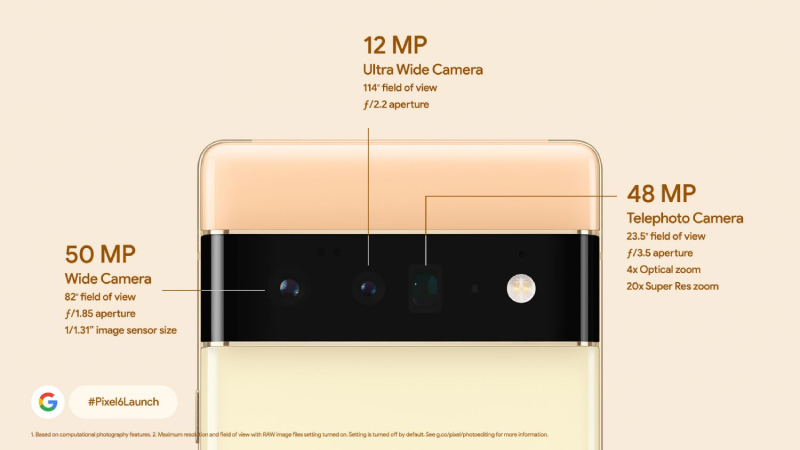Apple continued to impress the crowd with its launch of its third-generation entry-level AirPods and powerful M1 Pro and M1 Max chips, but Google is certainly not falling behind on the tech hype.
Following weeks of leaked visuals, the tech giant has finally unveiled the Pixel 6 and Pixel 6 Pro in all their glory, with the company's first custom mobile chip serving as the driving force behind many of the new features, including camera, security, and real-time translation upgrades.
At the core of the next-in-line flagship experience is the intuitive, all powerful Google Tensor chip that has given a new definition to AI-driven smartphone innovation.
While the 20 core GPU is a welcome treat (especially for gamers), the upgrade is of little noteworthiness in the grand scheme of things, simply because there's plenty to be awed by here.
First, the basics. Available in the Stormy Black, Kinda Coral, and Sorta Seafoam colourways, the Pixel 6 ships with a 6.4-inch, 90Hz FHD+ (2220 x 1080 pixels) display and 8GB of RAM.
The Pixel 6 Pro, meanwhile, comes in Stormy Black, Cloudy White, and Sorta Sunny, and offers a 6.7-inch, 120Hz QHD+ (3200 x 1800 pixels) display and 12 GB of RAM.
Both will boast an on-screen fingerprint sensor, water and dust resistance, and a 4,524mAh battery cell.
The camera capabilities of the phones are mind-blowingly impressive, and we don't only mean that in terms of figures.
Both models boast the same 50-megapixel main sensor and a 12-megapixel ultrawide camera; the latter offers an additional four times optical zoom 48-megapixel telephoto camera — making it the first in the family to boast a triple-camera system — as well as optical image stabilisation in every single lens.

In comparison, its sibling only has it in the main camera. More awe-inducing, though, is the line-up's offerings of camera improvements.
The Magic Eraser, which was first leaked in Australia via an ad for the phone, lets users edit out and remove unwanted objects or people in the background of their photos by scribbling over them.
Think Photoshop's Content Aware tool, if you'd like.
Meanwhile, Face Unblur identifies a face in an image and will try to keep it as sharp as possible, even if the subject is in motion.
Real Tone, a pretty cool feature that encourages inclusion and diversity, is designed to capture skin tones more accurately, particularly that of Bipoc (Black, Indigenous, and People of Colour) individuals.
The excitement continues with Motion Mode and Long Exposure. Where the former allows for clearer capture of moving subjects with Action Pans while blurring out the background, the latter goes on to add blur to them mid-action.
Speech recognition and real-time translation have also received a great boost.
Built to better identify natural-speaking patterns, accents, and dialects, Google Assistant is now more intuitive and intelligent than before — so much so that one is able to insert emojis using their voice, and issue commands like "Clear" and "Send."
Assistant Voice Typing, a new version of voice dictation typing in Google's Gboard keyboard, is another useful day-to-day companion.
Apart from understanding context, the phonetically-based feature is capable of adding punctuation automatically, and input a name into a text message as saved in the user's contact list.
Should translation be needed, Live Translate should prove to be a handy tool.
Not only will users be able to get a real-time translation of signs in foreign language with the point of a camera, it can translate texts in another language into their default language and let them respond in that same language via messaging apps.
More impressively, the Pixel 6 phones are able to simultaneously translate and transcribe videos that play on the screen as well.
For the spoken word, Assistant can serve as your interpreter, and translate what's being said in real time.
The livestream showed off its prowess with renowned Japanese personality Marie Kondo, and it got us totally convinced.
[embed]https://twitter.com/MarieKondo/status/1450531105707216900[/embed]
Another big focus for the Pixel 6 and Pixel 6 Pro is security and privacy, and there are several upgrades on that front.
The Privacy Dashboard, for example, enables users to set camera and microphone access for apps, and toggle it off from the quick settings tiles, while Google's new Titan M2 chip can monitor malware and potential phishing attempts across various apps.
Lastly, the company is promising at least five years of security updates, up from three.
For Snapchat users, a new feature lies in wait. A collaborative effort between the two companies sees the introduction of the 'Quick Tap to Snap' function, which allows them to create Snaps without having to unlock their device.
[[nid:547637]]
Do note, however, that authentication is still required to share those pictures via the app.
Snap and Google will also bring exclusive augmented reality Lenses alongside some of Google's key Pixel features, such as live translation, to the Snapchat's chat feature on the Pixel 6.
Essentially, users are able to talk to their friends in more than 10 languages with conversations translated in real-time.
The Google Pixel 6 and Pixel 6 Pro won't be available in all markets at launch, but Australia, Canada, France, Germany, Ireland, Japan, Taiwan, UK, and the States are getting first dibs based on country store refresh.
For the US crowd, the phones are set to retail at US$599 (S$805) and US$899 respectively, and those who are already keen on them can start pre-ordering now. Singapore audiences, unfortunately, will have to wait.
Google really outdid itself this time!
This article was first published in Geek Culture.

